Literature Review on Rheumatoid Arthritis
VerifiedAdded on 2021/04/22
|14
|3678
|107
AI Summary
The provided document appears to be a literature review assignment on rheumatoid arthritis. It includes references to various studies and articles that discuss patient perceptions, educational needs of nurses, and barriers to effective management of the condition. The assignment may require students to analyze these sources, identify key themes and findings, and present their own synthesis or recommendations for future research or practice.
Contribute Materials
Your contribution can guide someone’s learning journey. Share your
documents today.
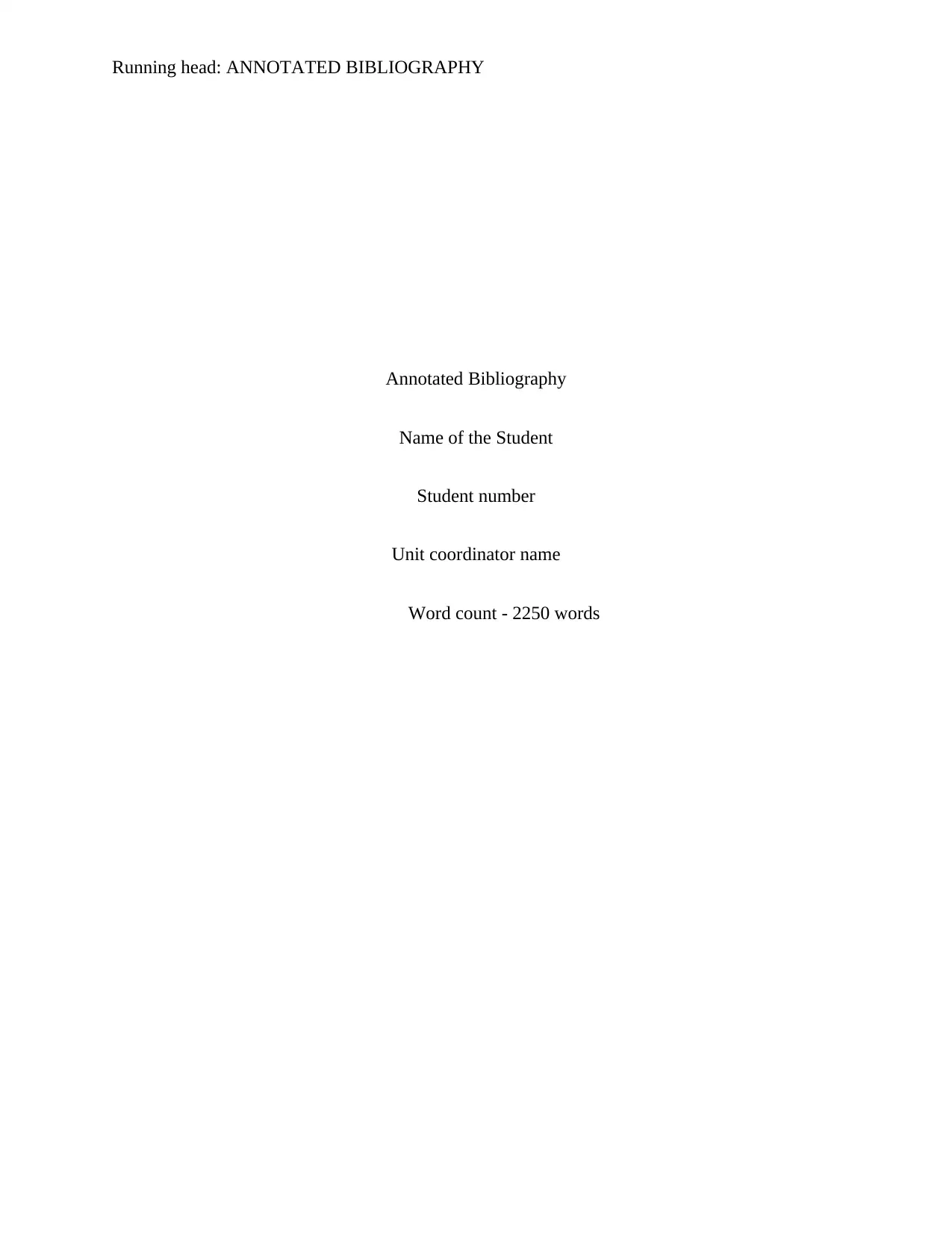
Running head: ANNOTATED BIBLIOGRAPHY
Annotated Bibliography
Name of the Student
Student number
Unit coordinator name
Word count - 2250 words
Annotated Bibliography
Name of the Student
Student number
Unit coordinator name
Word count - 2250 words
Secure Best Marks with AI Grader
Need help grading? Try our AI Grader for instant feedback on your assignments.
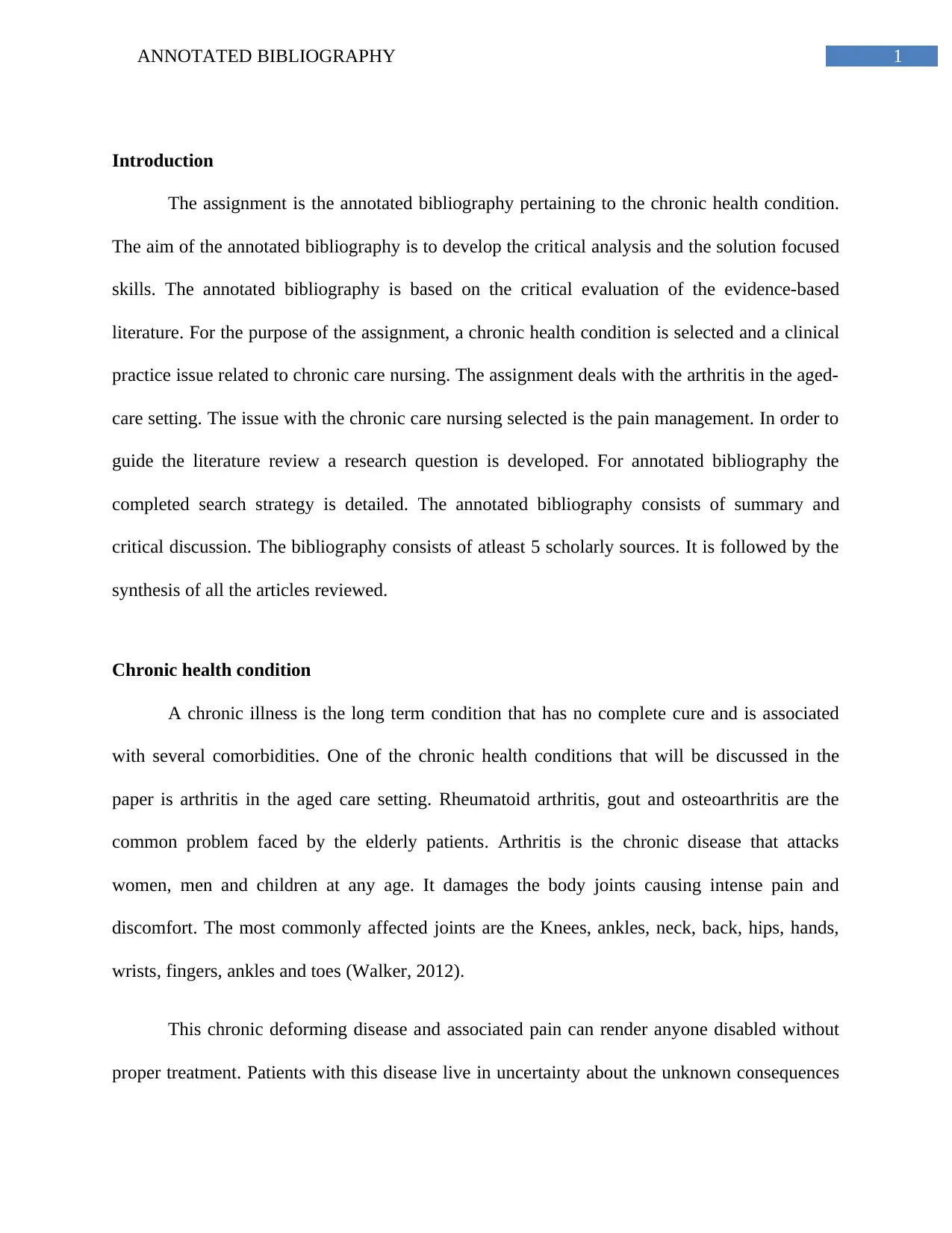
1ANNOTATED BIBLIOGRAPHY
Introduction
The assignment is the annotated bibliography pertaining to the chronic health condition.
The aim of the annotated bibliography is to develop the critical analysis and the solution focused
skills. The annotated bibliography is based on the critical evaluation of the evidence-based
literature. For the purpose of the assignment, a chronic health condition is selected and a clinical
practice issue related to chronic care nursing. The assignment deals with the arthritis in the aged-
care setting. The issue with the chronic care nursing selected is the pain management. In order to
guide the literature review a research question is developed. For annotated bibliography the
completed search strategy is detailed. The annotated bibliography consists of summary and
critical discussion. The bibliography consists of atleast 5 scholarly sources. It is followed by the
synthesis of all the articles reviewed.
Chronic health condition
A chronic illness is the long term condition that has no complete cure and is associated
with several comorbidities. One of the chronic health conditions that will be discussed in the
paper is arthritis in the aged care setting. Rheumatoid arthritis, gout and osteoarthritis are the
common problem faced by the elderly patients. Arthritis is the chronic disease that attacks
women, men and children at any age. It damages the body joints causing intense pain and
discomfort. The most commonly affected joints are the Knees, ankles, neck, back, hips, hands,
wrists, fingers, ankles and toes (Walker, 2012).
This chronic deforming disease and associated pain can render anyone disabled without
proper treatment. Patients with this disease live in uncertainty about the unknown consequences
Introduction
The assignment is the annotated bibliography pertaining to the chronic health condition.
The aim of the annotated bibliography is to develop the critical analysis and the solution focused
skills. The annotated bibliography is based on the critical evaluation of the evidence-based
literature. For the purpose of the assignment, a chronic health condition is selected and a clinical
practice issue related to chronic care nursing. The assignment deals with the arthritis in the aged-
care setting. The issue with the chronic care nursing selected is the pain management. In order to
guide the literature review a research question is developed. For annotated bibliography the
completed search strategy is detailed. The annotated bibliography consists of summary and
critical discussion. The bibliography consists of atleast 5 scholarly sources. It is followed by the
synthesis of all the articles reviewed.
Chronic health condition
A chronic illness is the long term condition that has no complete cure and is associated
with several comorbidities. One of the chronic health conditions that will be discussed in the
paper is arthritis in the aged care setting. Rheumatoid arthritis, gout and osteoarthritis are the
common problem faced by the elderly patients. Arthritis is the chronic disease that attacks
women, men and children at any age. It damages the body joints causing intense pain and
discomfort. The most commonly affected joints are the Knees, ankles, neck, back, hips, hands,
wrists, fingers, ankles and toes (Walker, 2012).
This chronic deforming disease and associated pain can render anyone disabled without
proper treatment. Patients with this disease live in uncertainty about the unknown consequences
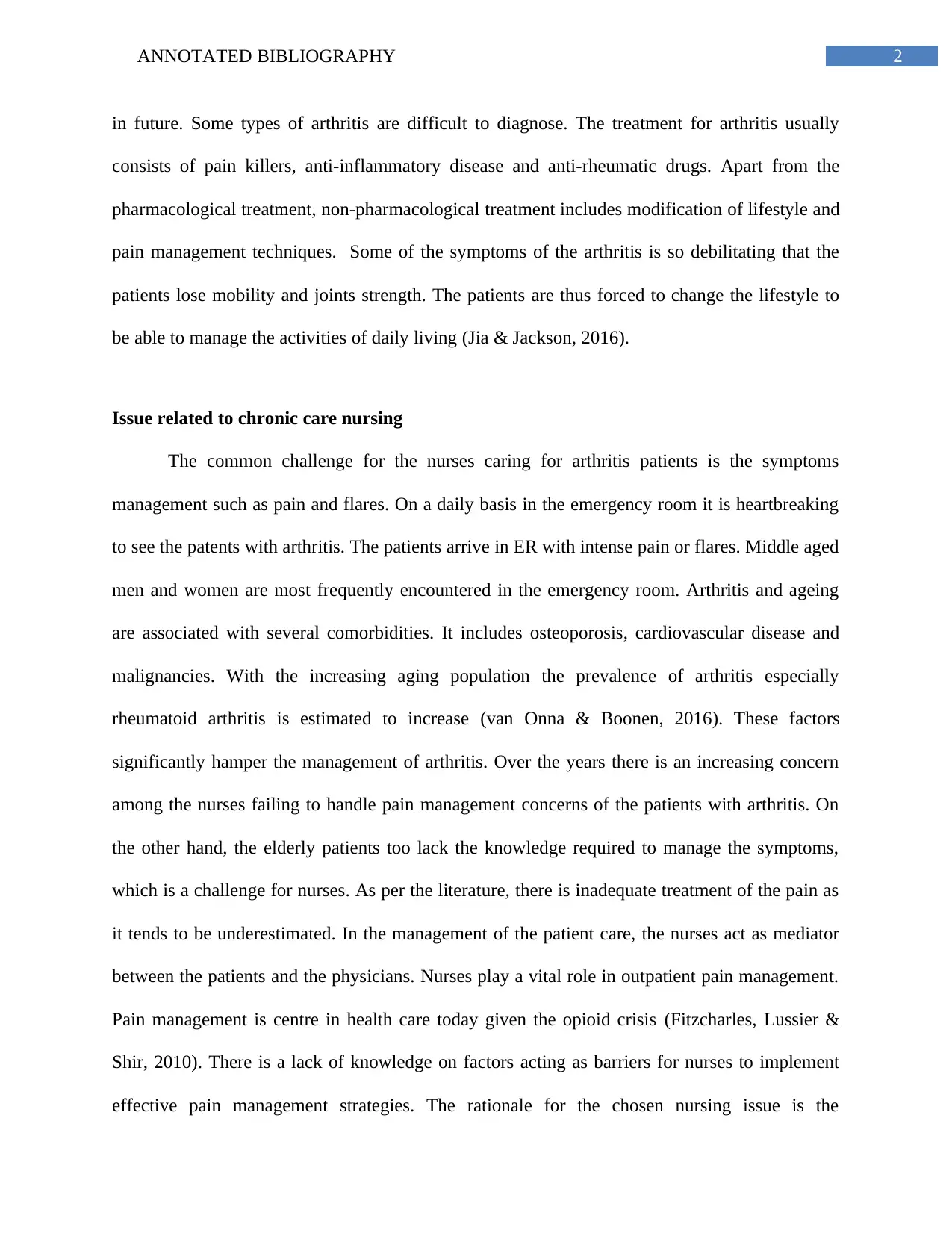
2ANNOTATED BIBLIOGRAPHY
in future. Some types of arthritis are difficult to diagnose. The treatment for arthritis usually
consists of pain killers, anti-inflammatory disease and anti-rheumatic drugs. Apart from the
pharmacological treatment, non-pharmacological treatment includes modification of lifestyle and
pain management techniques. Some of the symptoms of the arthritis is so debilitating that the
patients lose mobility and joints strength. The patients are thus forced to change the lifestyle to
be able to manage the activities of daily living (Jia & Jackson, 2016).
Issue related to chronic care nursing
The common challenge for the nurses caring for arthritis patients is the symptoms
management such as pain and flares. On a daily basis in the emergency room it is heartbreaking
to see the patents with arthritis. The patients arrive in ER with intense pain or flares. Middle aged
men and women are most frequently encountered in the emergency room. Arthritis and ageing
are associated with several comorbidities. It includes osteoporosis, cardiovascular disease and
malignancies. With the increasing aging population the prevalence of arthritis especially
rheumatoid arthritis is estimated to increase (van Onna & Boonen, 2016). These factors
significantly hamper the management of arthritis. Over the years there is an increasing concern
among the nurses failing to handle pain management concerns of the patients with arthritis. On
the other hand, the elderly patients too lack the knowledge required to manage the symptoms,
which is a challenge for nurses. As per the literature, there is inadequate treatment of the pain as
it tends to be underestimated. In the management of the patient care, the nurses act as mediator
between the patients and the physicians. Nurses play a vital role in outpatient pain management.
Pain management is centre in health care today given the opioid crisis (Fitzcharles, Lussier &
Shir, 2010). There is a lack of knowledge on factors acting as barriers for nurses to implement
effective pain management strategies. The rationale for the chosen nursing issue is the
in future. Some types of arthritis are difficult to diagnose. The treatment for arthritis usually
consists of pain killers, anti-inflammatory disease and anti-rheumatic drugs. Apart from the
pharmacological treatment, non-pharmacological treatment includes modification of lifestyle and
pain management techniques. Some of the symptoms of the arthritis is so debilitating that the
patients lose mobility and joints strength. The patients are thus forced to change the lifestyle to
be able to manage the activities of daily living (Jia & Jackson, 2016).
Issue related to chronic care nursing
The common challenge for the nurses caring for arthritis patients is the symptoms
management such as pain and flares. On a daily basis in the emergency room it is heartbreaking
to see the patents with arthritis. The patients arrive in ER with intense pain or flares. Middle aged
men and women are most frequently encountered in the emergency room. Arthritis and ageing
are associated with several comorbidities. It includes osteoporosis, cardiovascular disease and
malignancies. With the increasing aging population the prevalence of arthritis especially
rheumatoid arthritis is estimated to increase (van Onna & Boonen, 2016). These factors
significantly hamper the management of arthritis. Over the years there is an increasing concern
among the nurses failing to handle pain management concerns of the patients with arthritis. On
the other hand, the elderly patients too lack the knowledge required to manage the symptoms,
which is a challenge for nurses. As per the literature, there is inadequate treatment of the pain as
it tends to be underestimated. In the management of the patient care, the nurses act as mediator
between the patients and the physicians. Nurses play a vital role in outpatient pain management.
Pain management is centre in health care today given the opioid crisis (Fitzcharles, Lussier &
Shir, 2010). There is a lack of knowledge on factors acting as barriers for nurses to implement
effective pain management strategies. The rationale for the chosen nursing issue is the
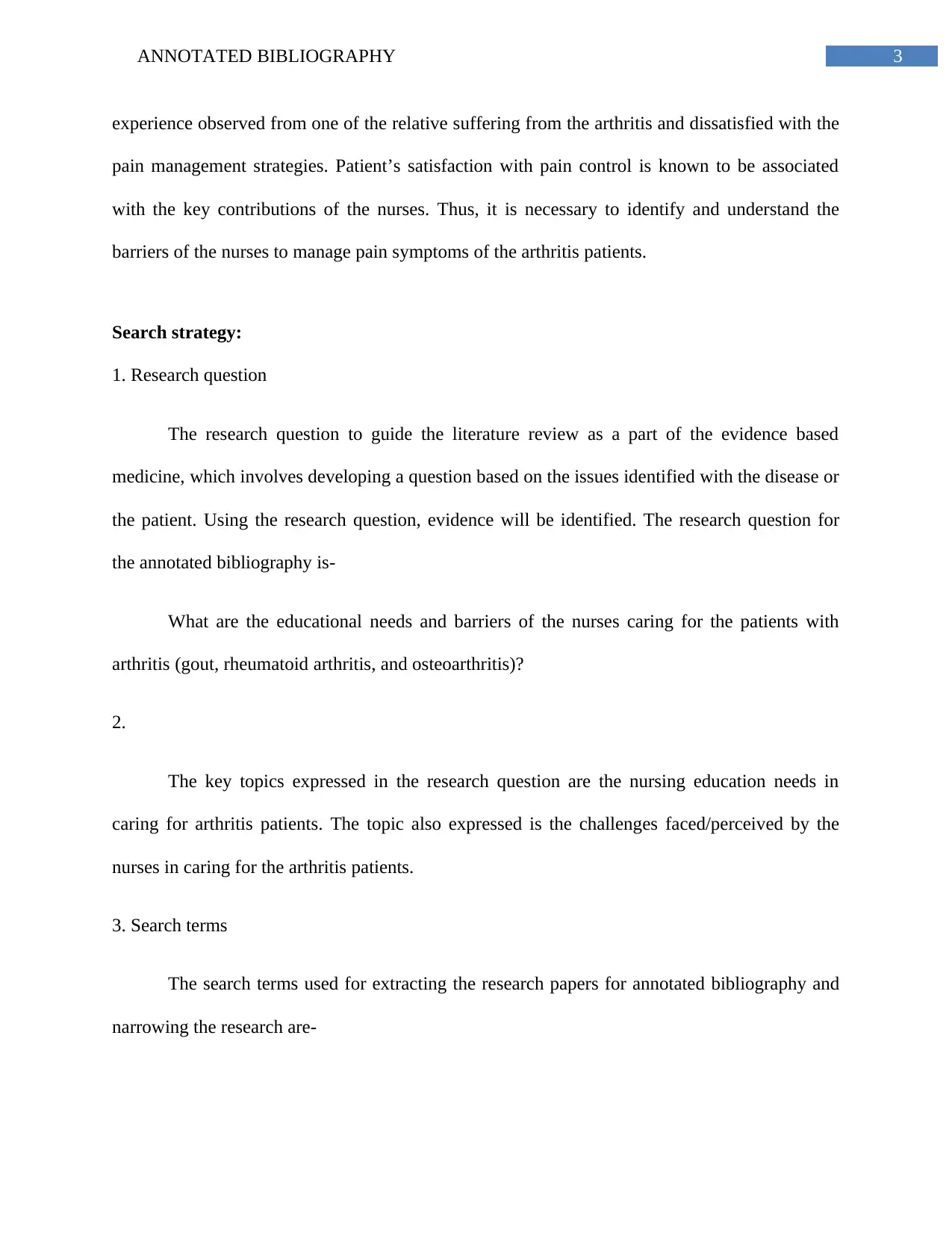
3ANNOTATED BIBLIOGRAPHY
experience observed from one of the relative suffering from the arthritis and dissatisfied with the
pain management strategies. Patient’s satisfaction with pain control is known to be associated
with the key contributions of the nurses. Thus, it is necessary to identify and understand the
barriers of the nurses to manage pain symptoms of the arthritis patients.
Search strategy:
1. Research question
The research question to guide the literature review as a part of the evidence based
medicine, which involves developing a question based on the issues identified with the disease or
the patient. Using the research question, evidence will be identified. The research question for
the annotated bibliography is-
What are the educational needs and barriers of the nurses caring for the patients with
arthritis (gout, rheumatoid arthritis, and osteoarthritis)?
2.
The key topics expressed in the research question are the nursing education needs in
caring for arthritis patients. The topic also expressed is the challenges faced/perceived by the
nurses in caring for the arthritis patients.
3. Search terms
The search terms used for extracting the research papers for annotated bibliography and
narrowing the research are-
experience observed from one of the relative suffering from the arthritis and dissatisfied with the
pain management strategies. Patient’s satisfaction with pain control is known to be associated
with the key contributions of the nurses. Thus, it is necessary to identify and understand the
barriers of the nurses to manage pain symptoms of the arthritis patients.
Search strategy:
1. Research question
The research question to guide the literature review as a part of the evidence based
medicine, which involves developing a question based on the issues identified with the disease or
the patient. Using the research question, evidence will be identified. The research question for
the annotated bibliography is-
What are the educational needs and barriers of the nurses caring for the patients with
arthritis (gout, rheumatoid arthritis, and osteoarthritis)?
2.
The key topics expressed in the research question are the nursing education needs in
caring for arthritis patients. The topic also expressed is the challenges faced/perceived by the
nurses in caring for the arthritis patients.
3. Search terms
The search terms used for extracting the research papers for annotated bibliography and
narrowing the research are-
Secure Best Marks with AI Grader
Need help grading? Try our AI Grader for instant feedback on your assignments.
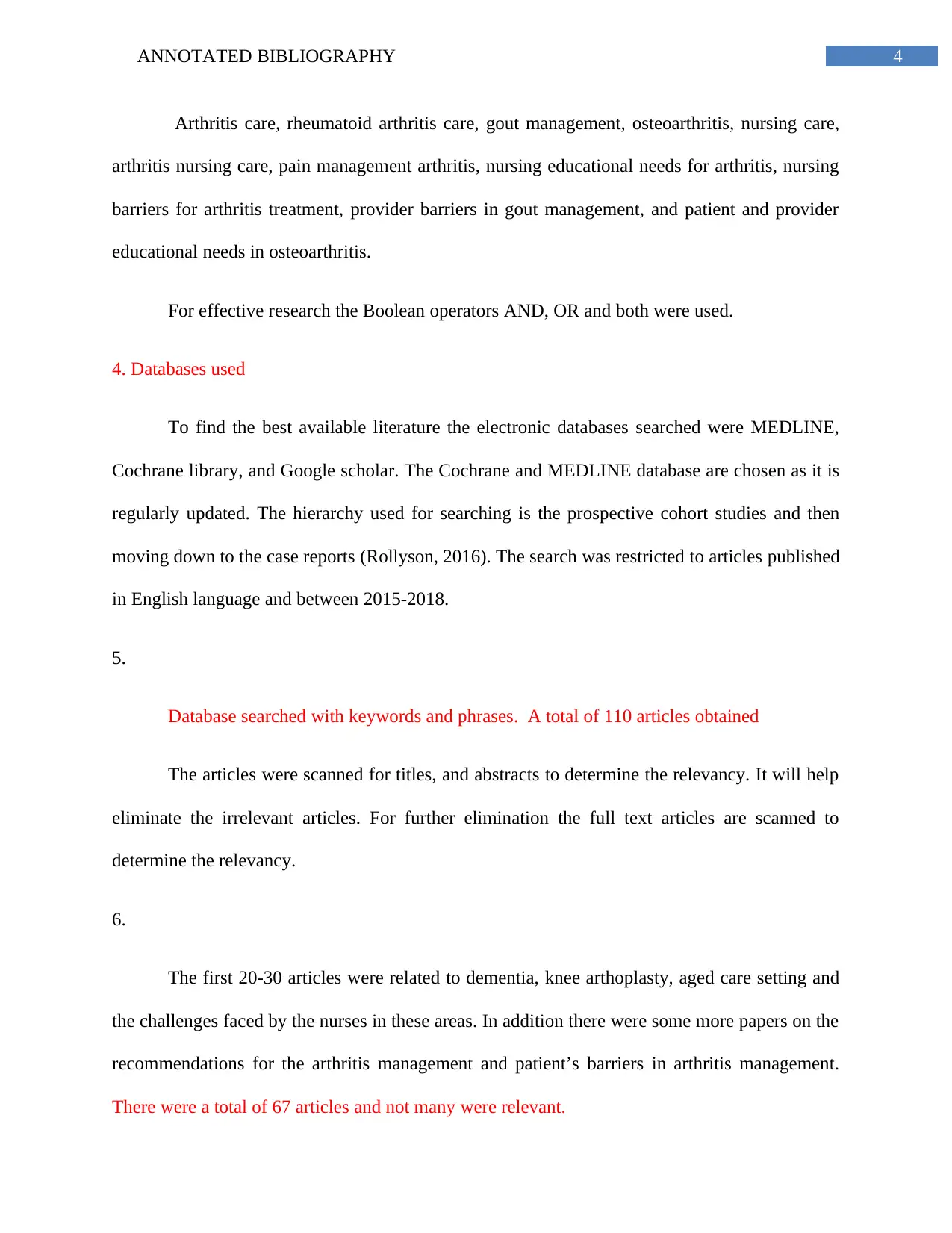
4ANNOTATED BIBLIOGRAPHY
Arthritis care, rheumatoid arthritis care, gout management, osteoarthritis, nursing care,
arthritis nursing care, pain management arthritis, nursing educational needs for arthritis, nursing
barriers for arthritis treatment, provider barriers in gout management, and patient and provider
educational needs in osteoarthritis.
For effective research the Boolean operators AND, OR and both were used.
4. Databases used
To find the best available literature the electronic databases searched were MEDLINE,
Cochrane library, and Google scholar. The Cochrane and MEDLINE database are chosen as it is
regularly updated. The hierarchy used for searching is the prospective cohort studies and then
moving down to the case reports (Rollyson, 2016). The search was restricted to articles published
in English language and between 2015-2018.
5.
Database searched with keywords and phrases. A total of 110 articles obtained
The articles were scanned for titles, and abstracts to determine the relevancy. It will help
eliminate the irrelevant articles. For further elimination the full text articles are scanned to
determine the relevancy.
6.
The first 20-30 articles were related to dementia, knee arthoplasty, aged care setting and
the challenges faced by the nurses in these areas. In addition there were some more papers on the
recommendations for the arthritis management and patient’s barriers in arthritis management.
There were a total of 67 articles and not many were relevant.
Arthritis care, rheumatoid arthritis care, gout management, osteoarthritis, nursing care,
arthritis nursing care, pain management arthritis, nursing educational needs for arthritis, nursing
barriers for arthritis treatment, provider barriers in gout management, and patient and provider
educational needs in osteoarthritis.
For effective research the Boolean operators AND, OR and both were used.
4. Databases used
To find the best available literature the electronic databases searched were MEDLINE,
Cochrane library, and Google scholar. The Cochrane and MEDLINE database are chosen as it is
regularly updated. The hierarchy used for searching is the prospective cohort studies and then
moving down to the case reports (Rollyson, 2016). The search was restricted to articles published
in English language and between 2015-2018.
5.
Database searched with keywords and phrases. A total of 110 articles obtained
The articles were scanned for titles, and abstracts to determine the relevancy. It will help
eliminate the irrelevant articles. For further elimination the full text articles are scanned to
determine the relevancy.
6.
The first 20-30 articles were related to dementia, knee arthoplasty, aged care setting and
the challenges faced by the nurses in these areas. In addition there were some more papers on the
recommendations for the arthritis management and patient’s barriers in arthritis management.
There were a total of 67 articles and not many were relevant.
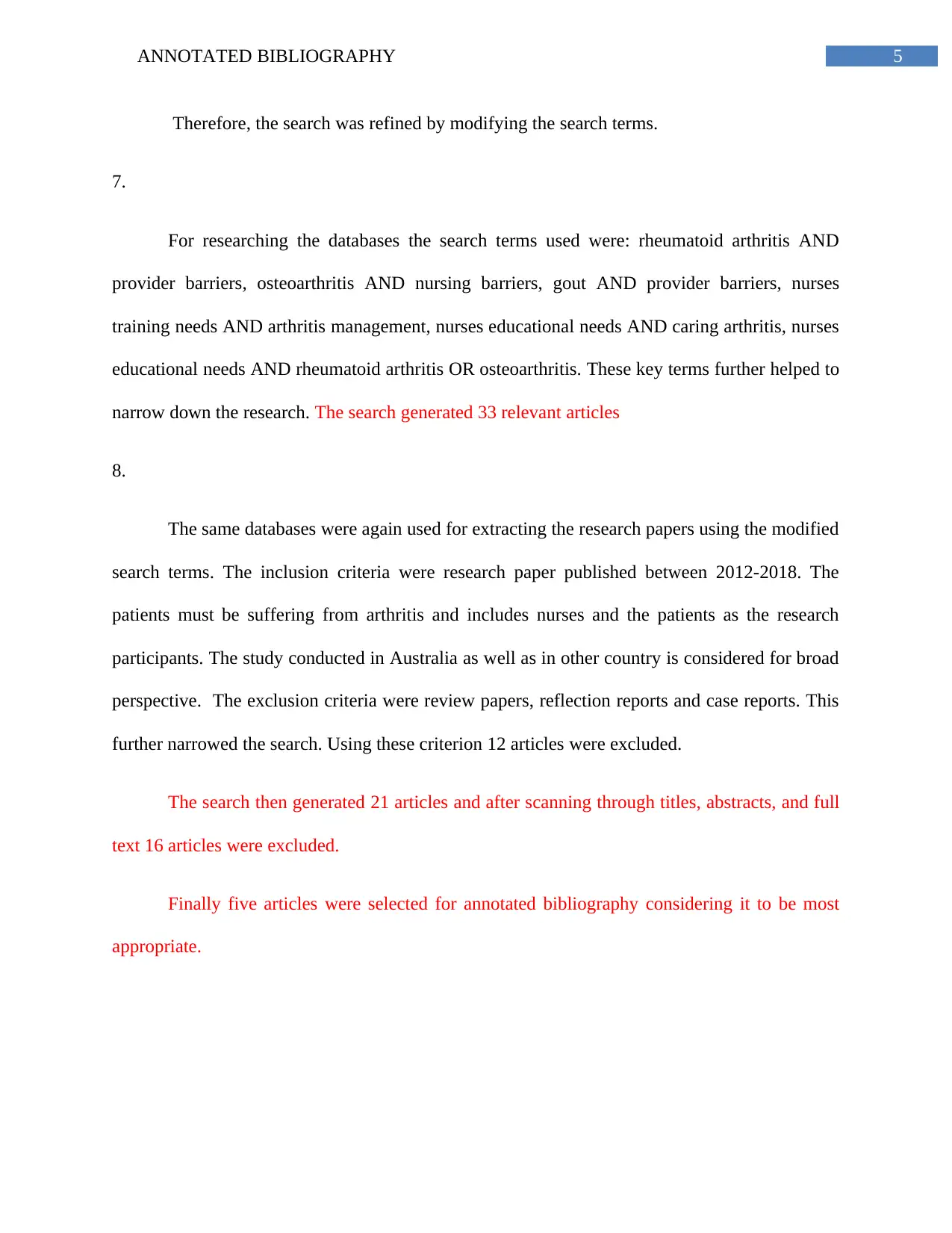
5ANNOTATED BIBLIOGRAPHY
Therefore, the search was refined by modifying the search terms.
7.
For researching the databases the search terms used were: rheumatoid arthritis AND
provider barriers, osteoarthritis AND nursing barriers, gout AND provider barriers, nurses
training needs AND arthritis management, nurses educational needs AND caring arthritis, nurses
educational needs AND rheumatoid arthritis OR osteoarthritis. These key terms further helped to
narrow down the research. The search generated 33 relevant articles
8.
The same databases were again used for extracting the research papers using the modified
search terms. The inclusion criteria were research paper published between 2012-2018. The
patients must be suffering from arthritis and includes nurses and the patients as the research
participants. The study conducted in Australia as well as in other country is considered for broad
perspective. The exclusion criteria were review papers, reflection reports and case reports. This
further narrowed the search. Using these criterion 12 articles were excluded.
The search then generated 21 articles and after scanning through titles, abstracts, and full
text 16 articles were excluded.
Finally five articles were selected for annotated bibliography considering it to be most
appropriate.
Therefore, the search was refined by modifying the search terms.
7.
For researching the databases the search terms used were: rheumatoid arthritis AND
provider barriers, osteoarthritis AND nursing barriers, gout AND provider barriers, nurses
training needs AND arthritis management, nurses educational needs AND caring arthritis, nurses
educational needs AND rheumatoid arthritis OR osteoarthritis. These key terms further helped to
narrow down the research. The search generated 33 relevant articles
8.
The same databases were again used for extracting the research papers using the modified
search terms. The inclusion criteria were research paper published between 2012-2018. The
patients must be suffering from arthritis and includes nurses and the patients as the research
participants. The study conducted in Australia as well as in other country is considered for broad
perspective. The exclusion criteria were review papers, reflection reports and case reports. This
further narrowed the search. Using these criterion 12 articles were excluded.
The search then generated 21 articles and after scanning through titles, abstracts, and full
text 16 articles were excluded.
Finally five articles were selected for annotated bibliography considering it to be most
appropriate.
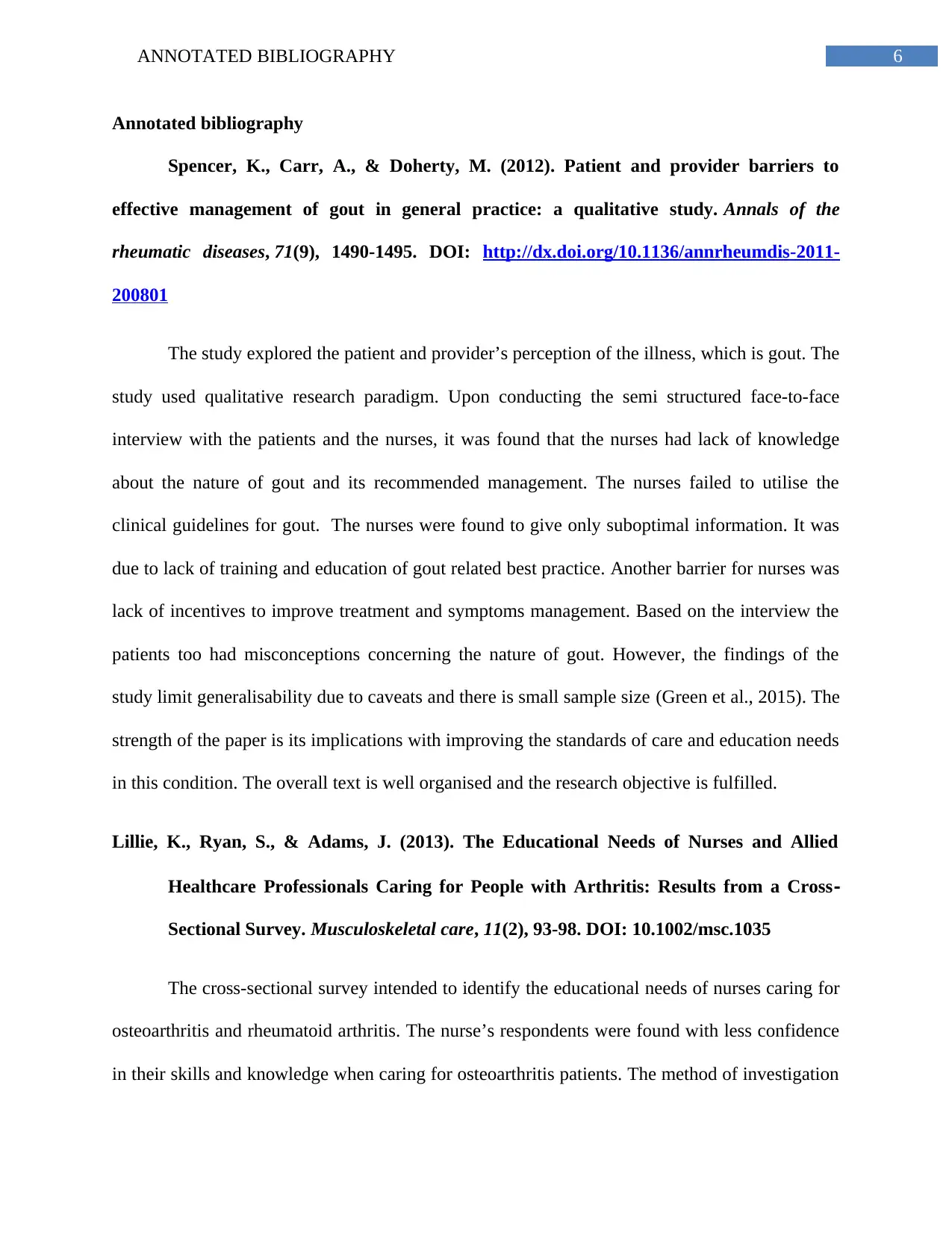
6ANNOTATED BIBLIOGRAPHY
Annotated bibliography
Spencer, K., Carr, A., & Doherty, M. (2012). Patient and provider barriers to
effective management of gout in general practice: a qualitative study. Annals of the
rheumatic diseases, 71(9), 1490-1495. DOI: http://dx.doi.org/10.1136/annrheumdis-2011-
200801
The study explored the patient and provider’s perception of the illness, which is gout. The
study used qualitative research paradigm. Upon conducting the semi structured face-to-face
interview with the patients and the nurses, it was found that the nurses had lack of knowledge
about the nature of gout and its recommended management. The nurses failed to utilise the
clinical guidelines for gout. The nurses were found to give only suboptimal information. It was
due to lack of training and education of gout related best practice. Another barrier for nurses was
lack of incentives to improve treatment and symptoms management. Based on the interview the
patients too had misconceptions concerning the nature of gout. However, the findings of the
study limit generalisability due to caveats and there is small sample size (Green et al., 2015). The
strength of the paper is its implications with improving the standards of care and education needs
in this condition. The overall text is well organised and the research objective is fulfilled.
Lillie, K., Ryan, S., & Adams, J. (2013). The Educational Needs of Nurses and Allied
Healthcare Professionals Caring for People with Arthritis: Results from a Cross‐
Sectional Survey. Musculoskeletal care, 11(2), 93-98. DOI: 10.1002/msc.1035
The cross-sectional survey intended to identify the educational needs of nurses caring for
osteoarthritis and rheumatoid arthritis. The nurse’s respondents were found with less confidence
in their skills and knowledge when caring for osteoarthritis patients. The method of investigation
Annotated bibliography
Spencer, K., Carr, A., & Doherty, M. (2012). Patient and provider barriers to
effective management of gout in general practice: a qualitative study. Annals of the
rheumatic diseases, 71(9), 1490-1495. DOI: http://dx.doi.org/10.1136/annrheumdis-2011-
200801
The study explored the patient and provider’s perception of the illness, which is gout. The
study used qualitative research paradigm. Upon conducting the semi structured face-to-face
interview with the patients and the nurses, it was found that the nurses had lack of knowledge
about the nature of gout and its recommended management. The nurses failed to utilise the
clinical guidelines for gout. The nurses were found to give only suboptimal information. It was
due to lack of training and education of gout related best practice. Another barrier for nurses was
lack of incentives to improve treatment and symptoms management. Based on the interview the
patients too had misconceptions concerning the nature of gout. However, the findings of the
study limit generalisability due to caveats and there is small sample size (Green et al., 2015). The
strength of the paper is its implications with improving the standards of care and education needs
in this condition. The overall text is well organised and the research objective is fulfilled.
Lillie, K., Ryan, S., & Adams, J. (2013). The Educational Needs of Nurses and Allied
Healthcare Professionals Caring for People with Arthritis: Results from a Cross‐
Sectional Survey. Musculoskeletal care, 11(2), 93-98. DOI: 10.1002/msc.1035
The cross-sectional survey intended to identify the educational needs of nurses caring for
osteoarthritis and rheumatoid arthritis. The nurse’s respondents were found with less confidence
in their skills and knowledge when caring for osteoarthritis patients. The method of investigation
Paraphrase This Document
Need a fresh take? Get an instant paraphrase of this document with our AI Paraphraser
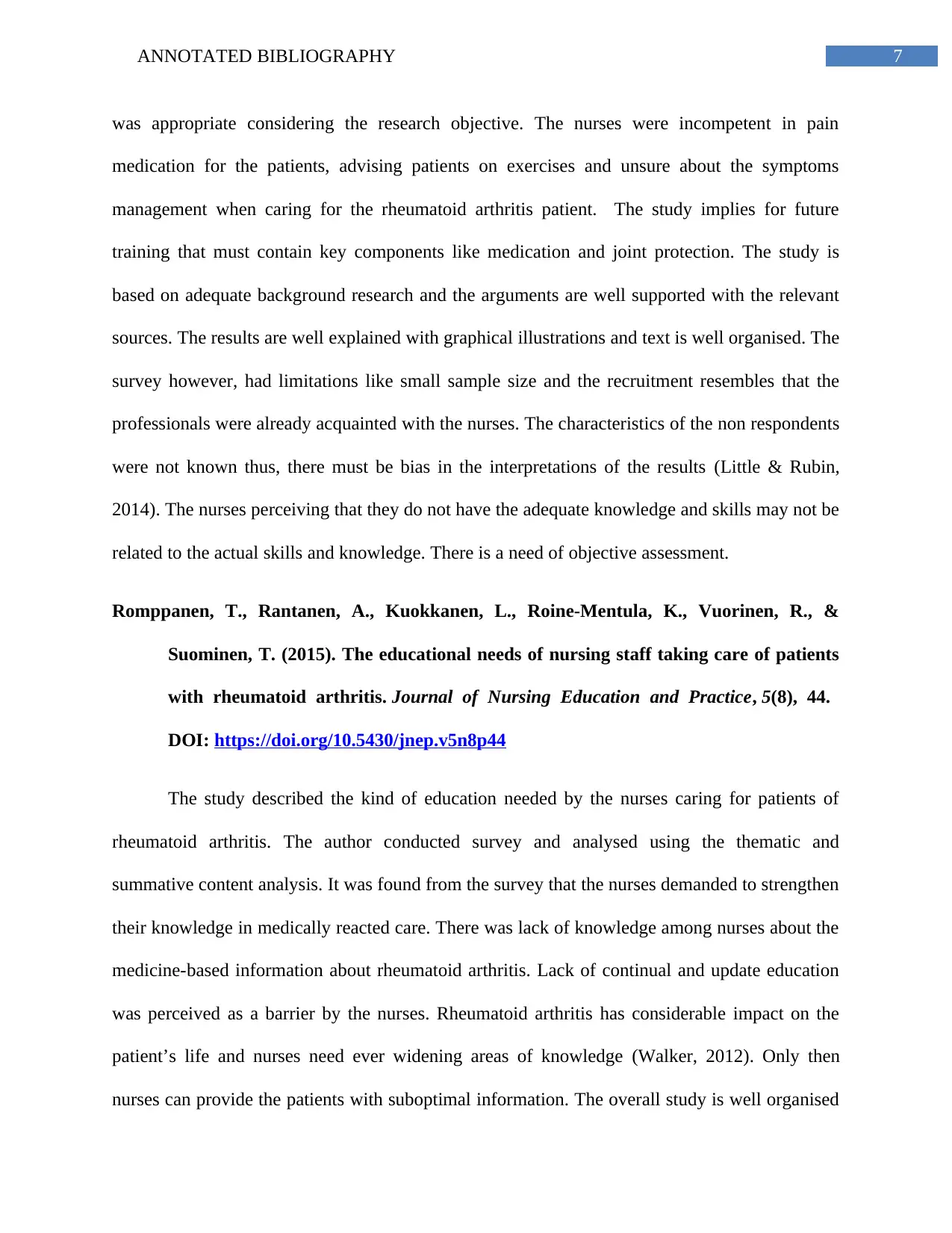
7ANNOTATED BIBLIOGRAPHY
was appropriate considering the research objective. The nurses were incompetent in pain
medication for the patients, advising patients on exercises and unsure about the symptoms
management when caring for the rheumatoid arthritis patient. The study implies for future
training that must contain key components like medication and joint protection. The study is
based on adequate background research and the arguments are well supported with the relevant
sources. The results are well explained with graphical illustrations and text is well organised. The
survey however, had limitations like small sample size and the recruitment resembles that the
professionals were already acquainted with the nurses. The characteristics of the non respondents
were not known thus, there must be bias in the interpretations of the results (Little & Rubin,
2014). The nurses perceiving that they do not have the adequate knowledge and skills may not be
related to the actual skills and knowledge. There is a need of objective assessment.
Romppanen, T., Rantanen, A., Kuokkanen, L., Roine-Mentula, K., Vuorinen, R., &
Suominen, T. (2015). The educational needs of nursing staff taking care of patients
with rheumatoid arthritis. Journal of Nursing Education and Practice, 5(8), 44.
DOI: https://doi.org/10.5430/jnep.v5n8p44
The study described the kind of education needed by the nurses caring for patients of
rheumatoid arthritis. The author conducted survey and analysed using the thematic and
summative content analysis. It was found from the survey that the nurses demanded to strengthen
their knowledge in medically reacted care. There was lack of knowledge among nurses about the
medicine-based information about rheumatoid arthritis. Lack of continual and update education
was perceived as a barrier by the nurses. Rheumatoid arthritis has considerable impact on the
patient’s life and nurses need ever widening areas of knowledge (Walker, 2012). Only then
nurses can provide the patients with suboptimal information. The overall study is well organised
was appropriate considering the research objective. The nurses were incompetent in pain
medication for the patients, advising patients on exercises and unsure about the symptoms
management when caring for the rheumatoid arthritis patient. The study implies for future
training that must contain key components like medication and joint protection. The study is
based on adequate background research and the arguments are well supported with the relevant
sources. The results are well explained with graphical illustrations and text is well organised. The
survey however, had limitations like small sample size and the recruitment resembles that the
professionals were already acquainted with the nurses. The characteristics of the non respondents
were not known thus, there must be bias in the interpretations of the results (Little & Rubin,
2014). The nurses perceiving that they do not have the adequate knowledge and skills may not be
related to the actual skills and knowledge. There is a need of objective assessment.
Romppanen, T., Rantanen, A., Kuokkanen, L., Roine-Mentula, K., Vuorinen, R., &
Suominen, T. (2015). The educational needs of nursing staff taking care of patients
with rheumatoid arthritis. Journal of Nursing Education and Practice, 5(8), 44.
DOI: https://doi.org/10.5430/jnep.v5n8p44
The study described the kind of education needed by the nurses caring for patients of
rheumatoid arthritis. The author conducted survey and analysed using the thematic and
summative content analysis. It was found from the survey that the nurses demanded to strengthen
their knowledge in medically reacted care. There was lack of knowledge among nurses about the
medicine-based information about rheumatoid arthritis. Lack of continual and update education
was perceived as a barrier by the nurses. Rheumatoid arthritis has considerable impact on the
patient’s life and nurses need ever widening areas of knowledge (Walker, 2012). Only then
nurses can provide the patients with suboptimal information. The overall study is well organised
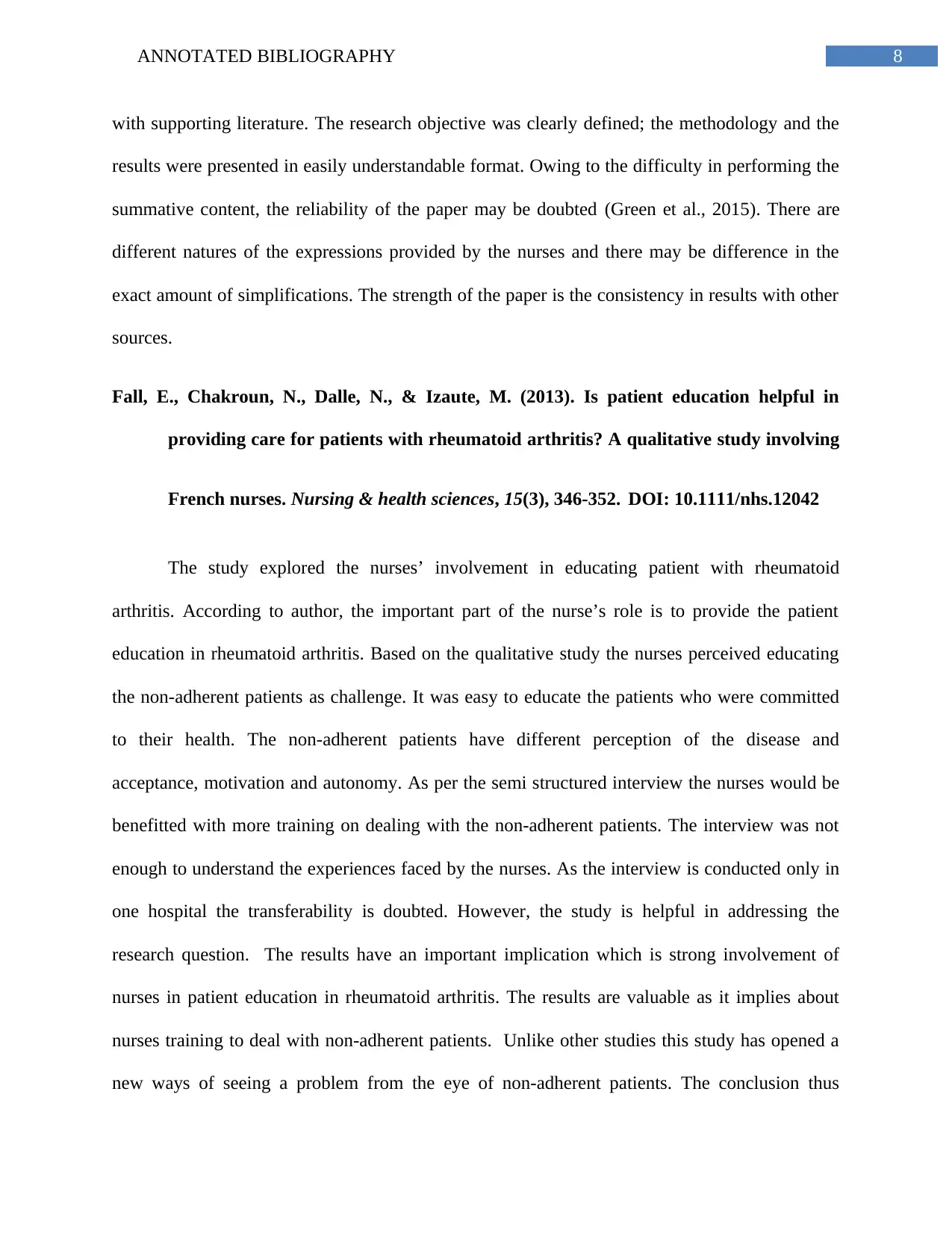
8ANNOTATED BIBLIOGRAPHY
with supporting literature. The research objective was clearly defined; the methodology and the
results were presented in easily understandable format. Owing to the difficulty in performing the
summative content, the reliability of the paper may be doubted (Green et al., 2015). There are
different natures of the expressions provided by the nurses and there may be difference in the
exact amount of simplifications. The strength of the paper is the consistency in results with other
sources.
Fall, E., Chakroun, N., Dalle, N., & Izaute, M. (2013). Is patient education helpful in
providing care for patients with rheumatoid arthritis? A qualitative study involving
French nurses. Nursing & health sciences, 15(3), 346-352. DOI: 10.1111/nhs.12042
The study explored the nurses’ involvement in educating patient with rheumatoid
arthritis. According to author, the important part of the nurse’s role is to provide the patient
education in rheumatoid arthritis. Based on the qualitative study the nurses perceived educating
the non-adherent patients as challenge. It was easy to educate the patients who were committed
to their health. The non-adherent patients have different perception of the disease and
acceptance, motivation and autonomy. As per the semi structured interview the nurses would be
benefitted with more training on dealing with the non-adherent patients. The interview was not
enough to understand the experiences faced by the nurses. As the interview is conducted only in
one hospital the transferability is doubted. However, the study is helpful in addressing the
research question. The results have an important implication which is strong involvement of
nurses in patient education in rheumatoid arthritis. The results are valuable as it implies about
nurses training to deal with non-adherent patients. Unlike other studies this study has opened a
new ways of seeing a problem from the eye of non-adherent patients. The conclusion thus
with supporting literature. The research objective was clearly defined; the methodology and the
results were presented in easily understandable format. Owing to the difficulty in performing the
summative content, the reliability of the paper may be doubted (Green et al., 2015). There are
different natures of the expressions provided by the nurses and there may be difference in the
exact amount of simplifications. The strength of the paper is the consistency in results with other
sources.
Fall, E., Chakroun, N., Dalle, N., & Izaute, M. (2013). Is patient education helpful in
providing care for patients with rheumatoid arthritis? A qualitative study involving
French nurses. Nursing & health sciences, 15(3), 346-352. DOI: 10.1111/nhs.12042
The study explored the nurses’ involvement in educating patient with rheumatoid
arthritis. According to author, the important part of the nurse’s role is to provide the patient
education in rheumatoid arthritis. Based on the qualitative study the nurses perceived educating
the non-adherent patients as challenge. It was easy to educate the patients who were committed
to their health. The non-adherent patients have different perception of the disease and
acceptance, motivation and autonomy. As per the semi structured interview the nurses would be
benefitted with more training on dealing with the non-adherent patients. The interview was not
enough to understand the experiences faced by the nurses. As the interview is conducted only in
one hospital the transferability is doubted. However, the study is helpful in addressing the
research question. The results have an important implication which is strong involvement of
nurses in patient education in rheumatoid arthritis. The results are valuable as it implies about
nurses training to deal with non-adherent patients. Unlike other studies this study has opened a
new ways of seeing a problem from the eye of non-adherent patients. The conclusion thus
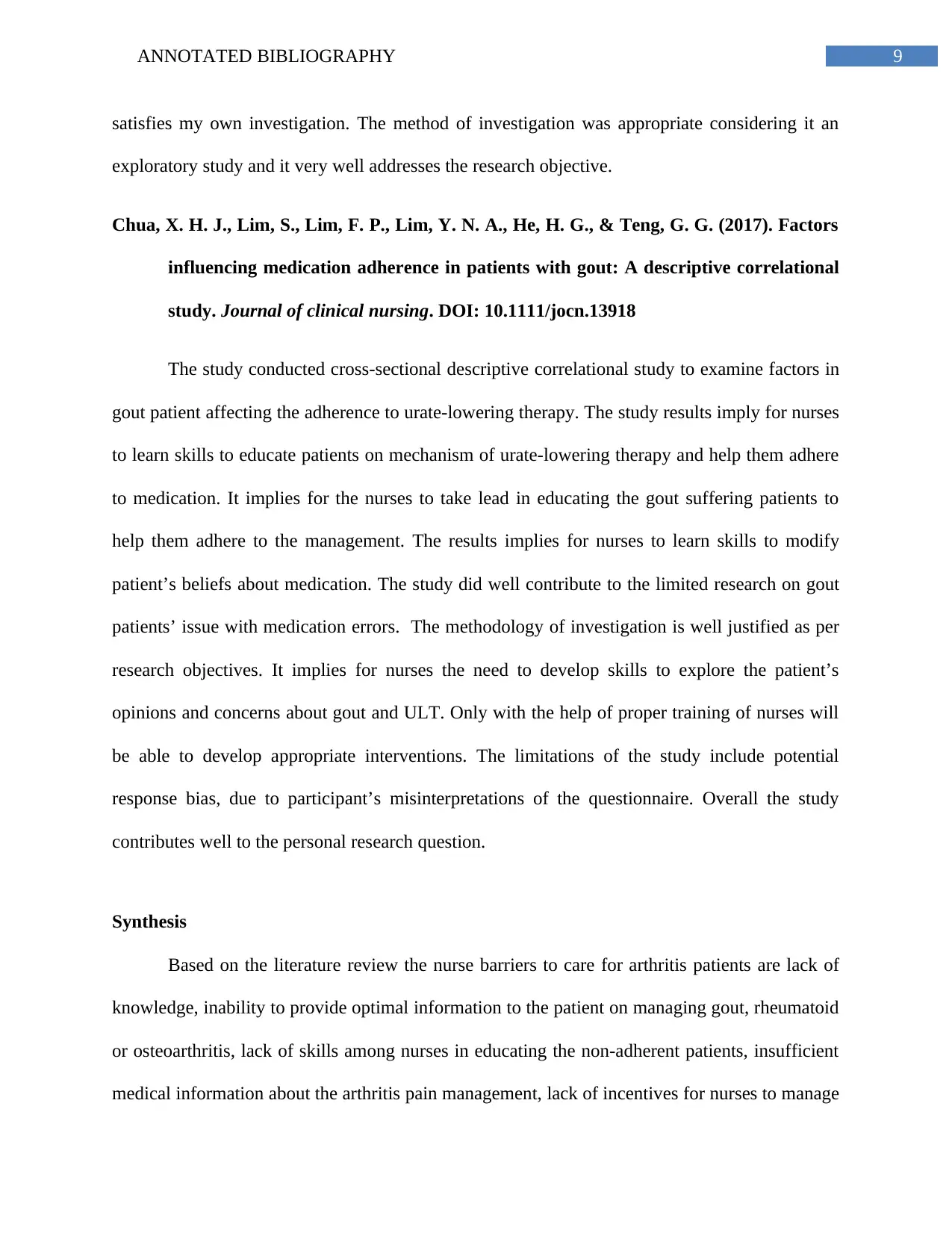
9ANNOTATED BIBLIOGRAPHY
satisfies my own investigation. The method of investigation was appropriate considering it an
exploratory study and it very well addresses the research objective.
Chua, X. H. J., Lim, S., Lim, F. P., Lim, Y. N. A., He, H. G., & Teng, G. G. (2017). Factors
influencing medication adherence in patients with gout: A descriptive correlational
study. Journal of clinical nursing. DOI: 10.1111/jocn.13918
The study conducted cross-sectional descriptive correlational study to examine factors in
gout patient affecting the adherence to urate-lowering therapy. The study results imply for nurses
to learn skills to educate patients on mechanism of urate-lowering therapy and help them adhere
to medication. It implies for the nurses to take lead in educating the gout suffering patients to
help them adhere to the management. The results implies for nurses to learn skills to modify
patient’s beliefs about medication. The study did well contribute to the limited research on gout
patients’ issue with medication errors. The methodology of investigation is well justified as per
research objectives. It implies for nurses the need to develop skills to explore the patient’s
opinions and concerns about gout and ULT. Only with the help of proper training of nurses will
be able to develop appropriate interventions. The limitations of the study include potential
response bias, due to participant’s misinterpretations of the questionnaire. Overall the study
contributes well to the personal research question.
Synthesis
Based on the literature review the nurse barriers to care for arthritis patients are lack of
knowledge, inability to provide optimal information to the patient on managing gout, rheumatoid
or osteoarthritis, lack of skills among nurses in educating the non-adherent patients, insufficient
medical information about the arthritis pain management, lack of incentives for nurses to manage
satisfies my own investigation. The method of investigation was appropriate considering it an
exploratory study and it very well addresses the research objective.
Chua, X. H. J., Lim, S., Lim, F. P., Lim, Y. N. A., He, H. G., & Teng, G. G. (2017). Factors
influencing medication adherence in patients with gout: A descriptive correlational
study. Journal of clinical nursing. DOI: 10.1111/jocn.13918
The study conducted cross-sectional descriptive correlational study to examine factors in
gout patient affecting the adherence to urate-lowering therapy. The study results imply for nurses
to learn skills to educate patients on mechanism of urate-lowering therapy and help them adhere
to medication. It implies for the nurses to take lead in educating the gout suffering patients to
help them adhere to the management. The results implies for nurses to learn skills to modify
patient’s beliefs about medication. The study did well contribute to the limited research on gout
patients’ issue with medication errors. The methodology of investigation is well justified as per
research objectives. It implies for nurses the need to develop skills to explore the patient’s
opinions and concerns about gout and ULT. Only with the help of proper training of nurses will
be able to develop appropriate interventions. The limitations of the study include potential
response bias, due to participant’s misinterpretations of the questionnaire. Overall the study
contributes well to the personal research question.
Synthesis
Based on the literature review the nurse barriers to care for arthritis patients are lack of
knowledge, inability to provide optimal information to the patient on managing gout, rheumatoid
or osteoarthritis, lack of skills among nurses in educating the non-adherent patients, insufficient
medical information about the arthritis pain management, lack of incentives for nurses to manage
Secure Best Marks with AI Grader
Need help grading? Try our AI Grader for instant feedback on your assignments.
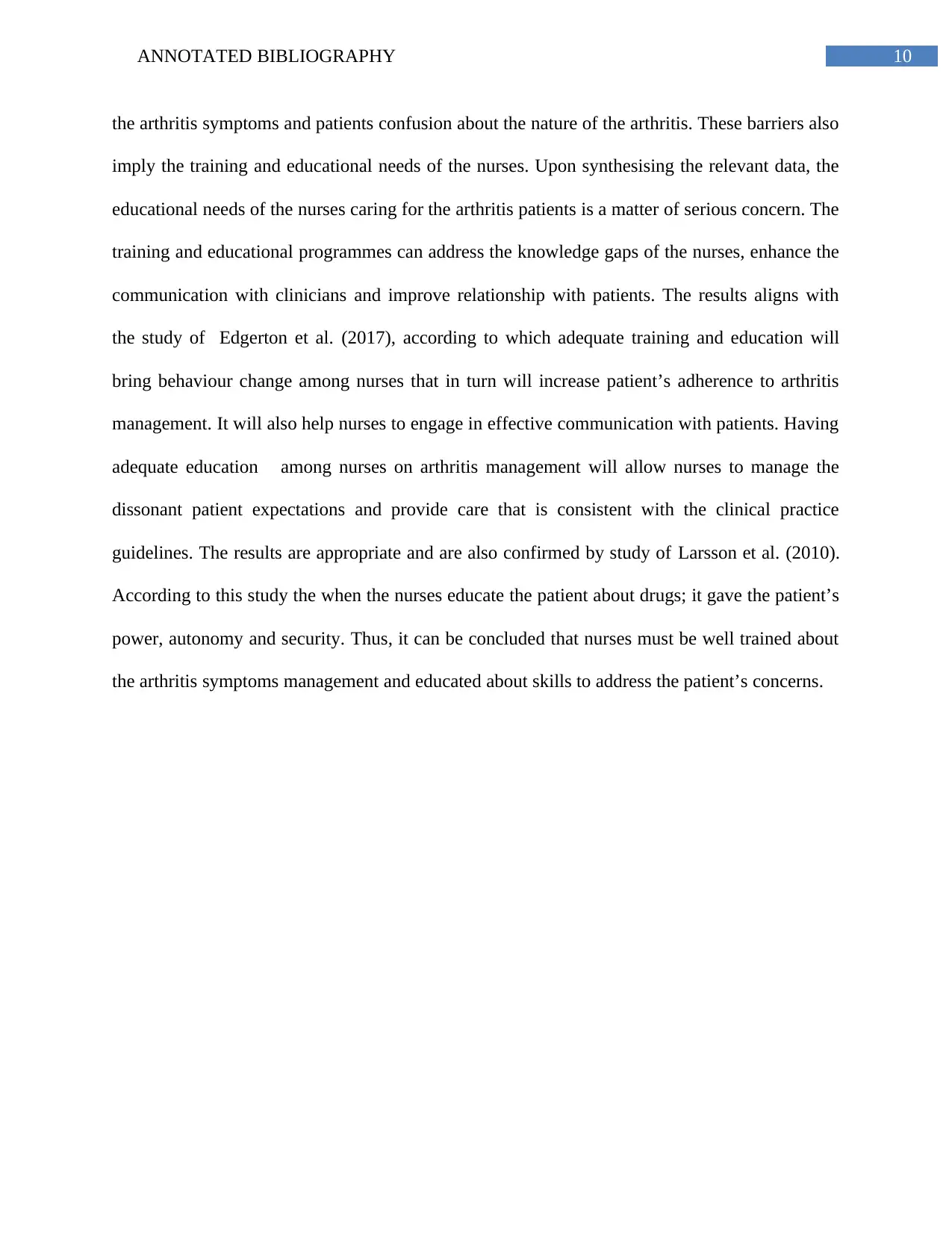
10ANNOTATED BIBLIOGRAPHY
the arthritis symptoms and patients confusion about the nature of the arthritis. These barriers also
imply the training and educational needs of the nurses. Upon synthesising the relevant data, the
educational needs of the nurses caring for the arthritis patients is a matter of serious concern. The
training and educational programmes can address the knowledge gaps of the nurses, enhance the
communication with clinicians and improve relationship with patients. The results aligns with
the study of Edgerton et al. (2017), according to which adequate training and education will
bring behaviour change among nurses that in turn will increase patient’s adherence to arthritis
management. It will also help nurses to engage in effective communication with patients. Having
adequate education among nurses on arthritis management will allow nurses to manage the
dissonant patient expectations and provide care that is consistent with the clinical practice
guidelines. The results are appropriate and are also confirmed by study of Larsson et al. (2010).
According to this study the when the nurses educate the patient about drugs; it gave the patient’s
power, autonomy and security. Thus, it can be concluded that nurses must be well trained about
the arthritis symptoms management and educated about skills to address the patient’s concerns.
the arthritis symptoms and patients confusion about the nature of the arthritis. These barriers also
imply the training and educational needs of the nurses. Upon synthesising the relevant data, the
educational needs of the nurses caring for the arthritis patients is a matter of serious concern. The
training and educational programmes can address the knowledge gaps of the nurses, enhance the
communication with clinicians and improve relationship with patients. The results aligns with
the study of Edgerton et al. (2017), according to which adequate training and education will
bring behaviour change among nurses that in turn will increase patient’s adherence to arthritis
management. It will also help nurses to engage in effective communication with patients. Having
adequate education among nurses on arthritis management will allow nurses to manage the
dissonant patient expectations and provide care that is consistent with the clinical practice
guidelines. The results are appropriate and are also confirmed by study of Larsson et al. (2010).
According to this study the when the nurses educate the patient about drugs; it gave the patient’s
power, autonomy and security. Thus, it can be concluded that nurses must be well trained about
the arthritis symptoms management and educated about skills to address the patient’s concerns.
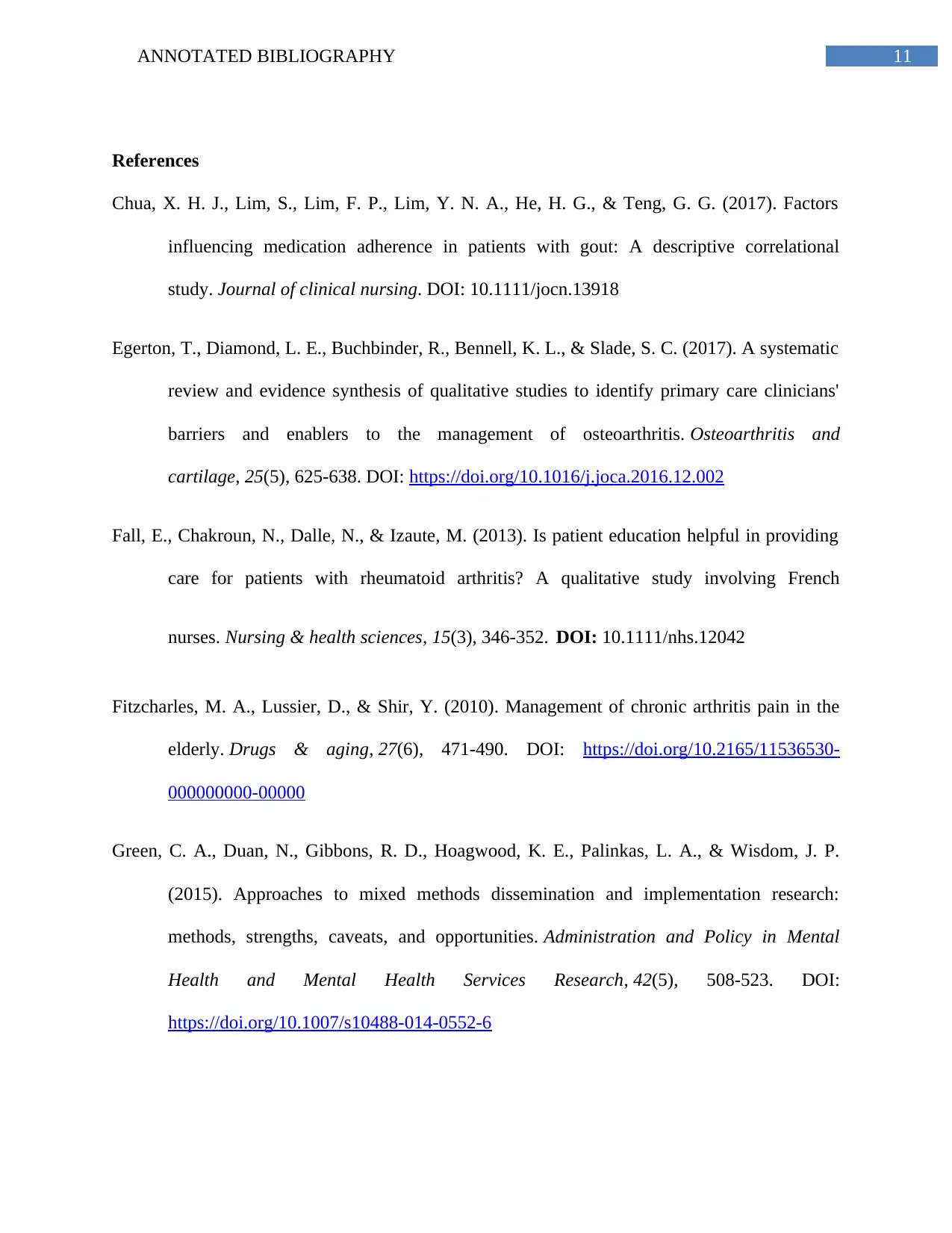
11ANNOTATED BIBLIOGRAPHY
References
Chua, X. H. J., Lim, S., Lim, F. P., Lim, Y. N. A., He, H. G., & Teng, G. G. (2017). Factors
influencing medication adherence in patients with gout: A descriptive correlational
study. Journal of clinical nursing. DOI: 10.1111/jocn.13918
Egerton, T., Diamond, L. E., Buchbinder, R., Bennell, K. L., & Slade, S. C. (2017). A systematic
review and evidence synthesis of qualitative studies to identify primary care clinicians'
barriers and enablers to the management of osteoarthritis. Osteoarthritis and
cartilage, 25(5), 625-638. DOI: https://doi.org/10.1016/j.joca.2016.12.002
Fall, E., Chakroun, N., Dalle, N., & Izaute, M. (2013). Is patient education helpful in providing
care for patients with rheumatoid arthritis? A qualitative study involving French
nurses. Nursing & health sciences, 15(3), 346-352. DOI: 10.1111/nhs.12042
Fitzcharles, M. A., Lussier, D., & Shir, Y. (2010). Management of chronic arthritis pain in the
elderly. Drugs & aging, 27(6), 471-490. DOI: https://doi.org/10.2165/11536530-
000000000-00000
Green, C. A., Duan, N., Gibbons, R. D., Hoagwood, K. E., Palinkas, L. A., & Wisdom, J. P.
(2015). Approaches to mixed methods dissemination and implementation research:
methods, strengths, caveats, and opportunities. Administration and Policy in Mental
Health and Mental Health Services Research, 42(5), 508-523. DOI:
https://doi.org/10.1007/s10488-014-0552-6
References
Chua, X. H. J., Lim, S., Lim, F. P., Lim, Y. N. A., He, H. G., & Teng, G. G. (2017). Factors
influencing medication adherence in patients with gout: A descriptive correlational
study. Journal of clinical nursing. DOI: 10.1111/jocn.13918
Egerton, T., Diamond, L. E., Buchbinder, R., Bennell, K. L., & Slade, S. C. (2017). A systematic
review and evidence synthesis of qualitative studies to identify primary care clinicians'
barriers and enablers to the management of osteoarthritis. Osteoarthritis and
cartilage, 25(5), 625-638. DOI: https://doi.org/10.1016/j.joca.2016.12.002
Fall, E., Chakroun, N., Dalle, N., & Izaute, M. (2013). Is patient education helpful in providing
care for patients with rheumatoid arthritis? A qualitative study involving French
nurses. Nursing & health sciences, 15(3), 346-352. DOI: 10.1111/nhs.12042
Fitzcharles, M. A., Lussier, D., & Shir, Y. (2010). Management of chronic arthritis pain in the
elderly. Drugs & aging, 27(6), 471-490. DOI: https://doi.org/10.2165/11536530-
000000000-00000
Green, C. A., Duan, N., Gibbons, R. D., Hoagwood, K. E., Palinkas, L. A., & Wisdom, J. P.
(2015). Approaches to mixed methods dissemination and implementation research:
methods, strengths, caveats, and opportunities. Administration and Policy in Mental
Health and Mental Health Services Research, 42(5), 508-523. DOI:
https://doi.org/10.1007/s10488-014-0552-6
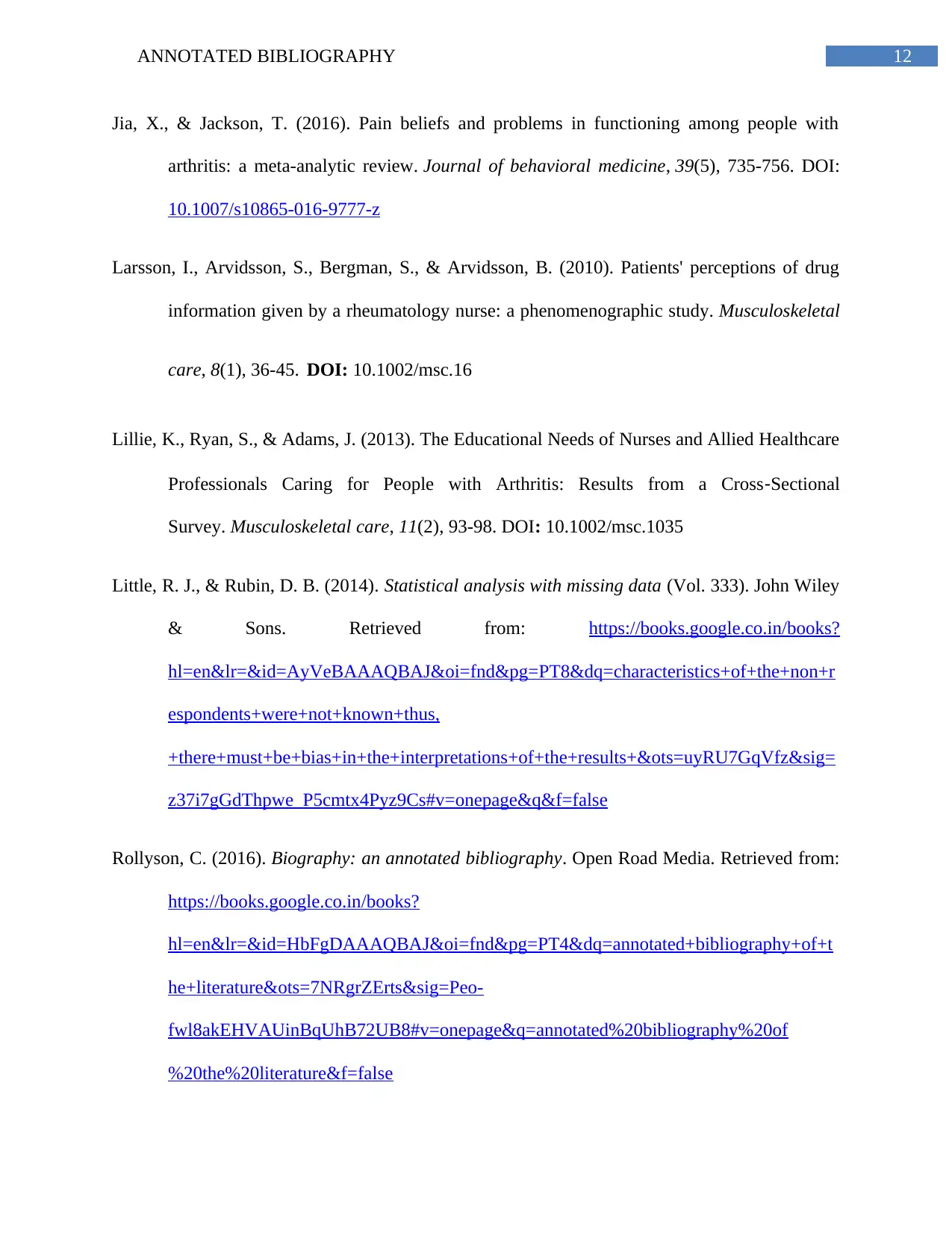
12ANNOTATED BIBLIOGRAPHY
Jia, X., & Jackson, T. (2016). Pain beliefs and problems in functioning among people with
arthritis: a meta-analytic review. Journal of behavioral medicine, 39(5), 735-756. DOI:
10.1007/s10865-016-9777-z
Larsson, I., Arvidsson, S., Bergman, S., & Arvidsson, B. (2010). Patients' perceptions of drug
information given by a rheumatology nurse: a phenomenographic study. Musculoskeletal
care, 8(1), 36-45. DOI: 10.1002/msc.16
Lillie, K., Ryan, S., & Adams, J. (2013). The Educational Needs of Nurses and Allied Healthcare
Professionals Caring for People with Arthritis: Results from a Cross‐Sectional
Survey. Musculoskeletal care, 11(2), 93-98. DOI: 10.1002/msc.1035
Little, R. J., & Rubin, D. B. (2014). Statistical analysis with missing data (Vol. 333). John Wiley
& Sons. Retrieved from: https://books.google.co.in/books?
hl=en&lr=&id=AyVeBAAAQBAJ&oi=fnd&pg=PT8&dq=characteristics+of+the+non+r
espondents+were+not+known+thus,
+there+must+be+bias+in+the+interpretations+of+the+results+&ots=uyRU7GqVfz&sig=
z37i7gGdThpwe_P5cmtx4Pyz9Cs#v=onepage&q&f=false
Rollyson, C. (2016). Biography: an annotated bibliography. Open Road Media. Retrieved from:
https://books.google.co.in/books?
hl=en&lr=&id=HbFgDAAAQBAJ&oi=fnd&pg=PT4&dq=annotated+bibliography+of+t
he+literature&ots=7NRgrZErts&sig=Peo-
fwl8akEHVAUinBqUhB72UB8#v=onepage&q=annotated%20bibliography%20of
%20the%20literature&f=false
Jia, X., & Jackson, T. (2016). Pain beliefs and problems in functioning among people with
arthritis: a meta-analytic review. Journal of behavioral medicine, 39(5), 735-756. DOI:
10.1007/s10865-016-9777-z
Larsson, I., Arvidsson, S., Bergman, S., & Arvidsson, B. (2010). Patients' perceptions of drug
information given by a rheumatology nurse: a phenomenographic study. Musculoskeletal
care, 8(1), 36-45. DOI: 10.1002/msc.16
Lillie, K., Ryan, S., & Adams, J. (2013). The Educational Needs of Nurses and Allied Healthcare
Professionals Caring for People with Arthritis: Results from a Cross‐Sectional
Survey. Musculoskeletal care, 11(2), 93-98. DOI: 10.1002/msc.1035
Little, R. J., & Rubin, D. B. (2014). Statistical analysis with missing data (Vol. 333). John Wiley
& Sons. Retrieved from: https://books.google.co.in/books?
hl=en&lr=&id=AyVeBAAAQBAJ&oi=fnd&pg=PT8&dq=characteristics+of+the+non+r
espondents+were+not+known+thus,
+there+must+be+bias+in+the+interpretations+of+the+results+&ots=uyRU7GqVfz&sig=
z37i7gGdThpwe_P5cmtx4Pyz9Cs#v=onepage&q&f=false
Rollyson, C. (2016). Biography: an annotated bibliography. Open Road Media. Retrieved from:
https://books.google.co.in/books?
hl=en&lr=&id=HbFgDAAAQBAJ&oi=fnd&pg=PT4&dq=annotated+bibliography+of+t
he+literature&ots=7NRgrZErts&sig=Peo-
fwl8akEHVAUinBqUhB72UB8#v=onepage&q=annotated%20bibliography%20of
%20the%20literature&f=false
Paraphrase This Document
Need a fresh take? Get an instant paraphrase of this document with our AI Paraphraser

13ANNOTATED BIBLIOGRAPHY
Romppanen, T., Rantanen, A., Kuokkanen, L., Roine-Mentula, K., Vuorinen, R., & Suominen,
T. (2015). The educational needs of nursing staff taking care of patients with rheumatoid
arthritis. Journal of Nursing Education and Practice, 5(8), 44.
DOI: https://doi.org/10.5430/jnep.v5n8p44
Spencer, K., Carr, A., & Doherty, M. (2012). Patient and provider barriers to effective
management of gout in general practice: a qualitative study. Annals of the rheumatic
diseases, 71(9), 1490-1495. DOI: http://dx.doi.org/10.1136/annrheumdis-2011-200801
Van Onna, M., & Boonen, A. (2016). The challenging interplay between rheumatoid arthritis,
ageing and comorbidities. BMC musculoskeletal disorders, 17(1), 184.DOI:
https://doi.org/10.1186/s12891-016-1038-3
Walker, J. (2012). Rheumatoid arthritis: role of the nurse and multidisciplinary team. British
journal of nursing, 21(6), 334-339. DOI: https://doi.org/10.12968/bjon.2012.21.6.334
Romppanen, T., Rantanen, A., Kuokkanen, L., Roine-Mentula, K., Vuorinen, R., & Suominen,
T. (2015). The educational needs of nursing staff taking care of patients with rheumatoid
arthritis. Journal of Nursing Education and Practice, 5(8), 44.
DOI: https://doi.org/10.5430/jnep.v5n8p44
Spencer, K., Carr, A., & Doherty, M. (2012). Patient and provider barriers to effective
management of gout in general practice: a qualitative study. Annals of the rheumatic
diseases, 71(9), 1490-1495. DOI: http://dx.doi.org/10.1136/annrheumdis-2011-200801
Van Onna, M., & Boonen, A. (2016). The challenging interplay between rheumatoid arthritis,
ageing and comorbidities. BMC musculoskeletal disorders, 17(1), 184.DOI:
https://doi.org/10.1186/s12891-016-1038-3
Walker, J. (2012). Rheumatoid arthritis: role of the nurse and multidisciplinary team. British
journal of nursing, 21(6), 334-339. DOI: https://doi.org/10.12968/bjon.2012.21.6.334
1 out of 14
Related Documents
Your All-in-One AI-Powered Toolkit for Academic Success.
+13062052269
info@desklib.com
Available 24*7 on WhatsApp / Email
![[object Object]](/_next/static/media/star-bottom.7253800d.svg)
Unlock your academic potential
© 2024 | Zucol Services PVT LTD | All rights reserved.





